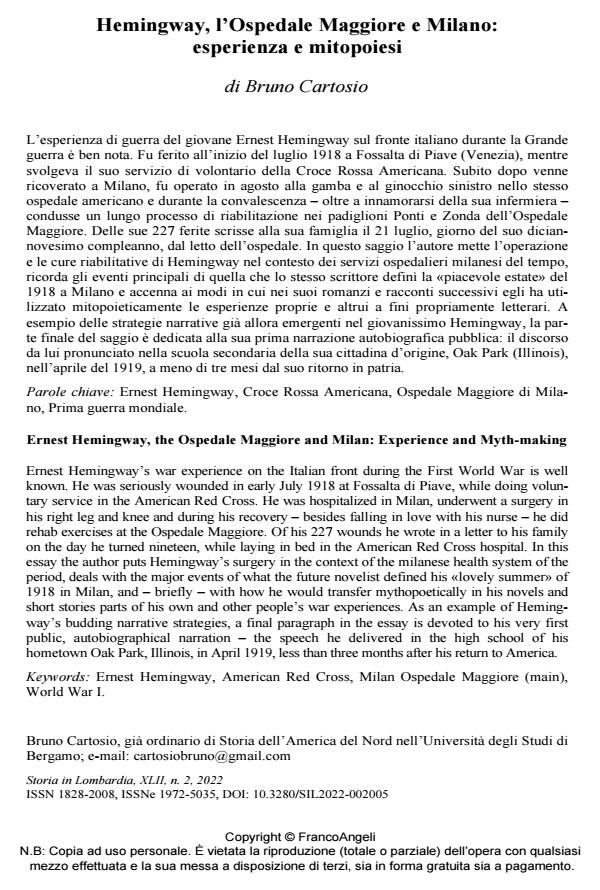Ernest Hemingway, the Ospedale Maggiore and Milan: Experience and Myth-making
Journal title STORIA IN LOMBARDIA
Author/s Bruno Cartosio
Publishing Year 2022 Issue 2022/2
Language Italian Pages 12 P. 109-120 File size 290 KB
DOI 10.3280/SIL2022-002005
DOI is like a bar code for intellectual property: to have more infomation
click here
Below, you can see the article first page
If you want to buy this article in PDF format, you can do it, following the instructions to buy download credits

FrancoAngeli is member of Publishers International Linking Association, Inc (PILA), a not-for-profit association which run the CrossRef service enabling links to and from online scholarly content.
Ernest Hemingway’s war experience on the Italian front during the First World War is well known. He was seriously wounded in early July 1918 at Fossalta di Piave, while doing volun- tary service in the American Red Cross. He was hospitalized in Milan, underwent a surgery in his right leg and knee and during his recovery - besides falling in love with his nurse - he did rehab exercises at the Ospedale Maggiore. Of his 227 wounds he wrote in a letter to his family on the day he turned nineteen, while laying in bed in the American Red Cross hospital. In this essay the author puts Hemingway’s surgery in the context of the milanese health system of the period, deals with the major events of what the future novelist defined his «lovely summer» of 1918 in Milan, and - briefly - with how he would transfer mythopoetically in his novels and short stories parts of his own and other people’s war experiences. As an example of Heming- way’s budding narrative strategies, a final paragraph in the essay is devoted to his very first public, autobiographical narration - the speech he delivered in the high school of his hometown Oak Park, Illinois, in April 1919, less than three months after his return to America.
Keywords: Ernest Hemingway, American Red Cross, Milan Ospedale Maggiore (main), World War I.
- Baker C. (1969), Ernest Hemingway. A Life Story, New York, Charles Scribner’s Sons.
- Id., a cura di (1981), Ernest Hemingway. Selected Letters, 1917-1961, New York, Charles Scribner’s Sons.
- Cecchin G. (1975), Invito alla lettura di Hemingway, Milano, Mursia.
- Id. (1980), Con Hemingway e Dos Passos sui campi di battaglia italiani della Grande Guerra, Milano, Mursia.
- Cosmacini G. (1999), La Ca’ Granda dei milanesi. Storia dell’Ospedale Maggiore, Bari-Roma, Laterza.
- Cummings E. E. (1922), The Enormous Room, New York, Boni & Liveright. Dos Passos J. (1921), Three Soldiers, New York, George H. Doran.
- Id. (1932), Nineteen-Nineteen, New York, Harcourt, Brace and Company.
- Franchini A. F., Un centro di fisioterapia e riabilitazione di primo Novecento in Mila- no: il padiglione meccanoterapico Ponti, in «Milano Città delle Scienze», 9 marzo 2009, pp. 1-3.
- Galliolo M. (2020), Ernest Hemingway e l’inedito italiano, in «rivistastudio.com», 19 giugno 2020 (consultato in data: novembre 2022).
- Hemingway E. (1926), The Sun Also Rises [Fiesta], New York, Charles Scribner’s Sons.
- Id. (1929), A Farewell to Arms, New York, Charles Scribner’s Sons.
- Id. (1938), The Fifth Column and the First Forty-Nine Stories, New York, Charles Scribner’s Sons, trad. it. di Trevisani G., I quarantanove racconti, 2 voll., Milano, Mondadori, 1959.
- Irwin J. F. (2009), Nation Building and Rebuilding: The American Red Cross in Italy During the Great War, in «Journal of the Gilded Age and Progressive Era», vol. 8, n. 3, pp. 407-439.
- Pivano F. (1985), Hemingway, Milano, Rusconi.
- Rennie D. A. (2018), The Real British Red Cross and Hemingway’s A Farewell to Arms, in «The Hemingway Review», vol. 37, n. 2, pp. 25-41.
- Vergani C. (2020), Chirurghi in prima linea. Storia degli ospedali chirurgici mobili nella Grande Guerra, Udine, Gaspari.
- Villard H. S. e Nagel J., a cura di (1996), Hemingway in Love and War: The Lost Dia- ries of Agnes von Kurowsky, New York, Hyperion.
Bruno Cartosio, Hemingway, l’Ospedale Maggiore e Milano: esperienza e mitopoiesi in "STORIA IN LOMBARDIA" 2/2022, pp 109-120, DOI: 10.3280/SIL2022-002005